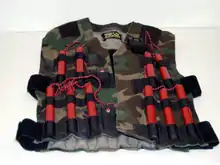Inghimasi
Inghimasi (Arabic: اِنْغِمَاسِيّ, romanized: Inġimāsīy, "become immersed"), also called shahid (Arabic: شهيد, "martyr") and istishhadi (Arabic: إستشهادي, "martyrdom seeker"),[1] are forlorn hope or suicide attack shock troops utilized by several jihadist Sunni Islamist militant groups, including the Islamic State of Iraq and the Levant (ISIL), al-Qaeda, Tahrir al-Sham (formerly Jabhat al-Nusra), Boko Haram, and al-Shabaab.

| Part of a series on |
| Jihadism |
|---|
| Islamic fundamentalism |
| Notable jihadist organisations |
| Jihadism in the East |
| Jihadism in the West |
|
|
Definition and etymology
Inghimasi are usually well-trained guerrilla fighters[2] who are organized into teams, and infiltrate enemy positions in order to cause as much damage as possible, generally expecting to be killed while doing so.[1] They often wear explosive belts that are to be detonated when the possibility arises that they could be captured, run out of ammunition, or expect to be overwhelmed.[2] Inghimasi fighters usually wear clothing resembling that of the target's forces, and use light weapons.[3] Inghimasi have to agree to a 'no return' policy, and expect to die in combat.[2][4] Unlike normal suicide attack forces, however, an Inghimasi can survive their missions and return to their base.[2][4] The Islamic State gives new recruits the option of becoming an Inghimasi when enlisting, along with the option of operating a SVBIED or being a regular fighter.[4] The word comes from the Arabic word Inghamasa (انغمس) meaning "to plunge" or "become immersed".[4][2]
History
Arabic media outlets first reported of Inghimasis in 2013 however its use on social media originates to 2011, the origin of the Inghimasi concept is attributed to al-Nusra.[4] As the Inghimasi concept is attributed to al-Nusra founded as the Syrian branch of the Islamic State of Iraq in early 2012 this method of attack became prominent during the Syrian Civil War and eventually the 2014-2017 Iraqi Civil War but the usage of Inghimasi tactics have also been used during the Second Libyan Civil War. Notable uses of Inghimasi operations include the Battle of Al-Tabqa airbase, the Siege of al-Fu'ah and Kafriya, the 2016 Battle of Kirkuk,[5] and various times during the 2012-2016 Battle of Aleppo such as during the Aleppo offensive in October and November 2016.[6]
The Inghimasi method of attack is not unique to the Middle East, and has been used in terrorist attacks outside the region. Al-Shabaab in Somalia is known to employ Inghimasis,[1] and the Islamic State's branch in Afghanistan uses them as well.[2] Furthermore, the individuals involved in the November 2015 Paris attacks operated in a similar fashion to Inghimasi.[4]
Notable Inghimasi members and operations
- Hudhayfah al-Badri, son of ISIL leader Abu Bakr al-Baghdadi, died in combat during an Inghimasi operation against the Syrian Army and Russian troops in Homs Governorate.[2]
- 2018 As-Suwayda attacks
- A raid by four inghimasi fighters belonging to the Islamic State's West Africa Province against Diffa in Niger on 9 April 2019 during the Chad Basin campaign (2018–2019)[7]
- A Taliban attack upon Forward Operating Base Salerno in Khost on June 2012 was technically an inghimasi.
References
- Anzalone (2018), p. 13.
- Thomas Joscelyn (3 July 2018). "Baghdadi's son killed fighting Syrian and Russian forces, Islamic State says". Long War Journal. Retrieved 4 July 2018.
- Studies, Middle East, politics, GCC, Iran, Syria, Iraq, Egypt, Saudi Arabia, UAE, Nuclear deal, Yemen, Trump, MENA, Turkey, Gulf Crisis, Qatar,Future for Advanced Research and. "Inghimasi Fighters: Terrorist Organizations Return to Previous Modus Operandi". Future Center. Retrieved 9 June 2018.
- "Inghimasi – The Secret ISIS Tactic Designed for the Digital Age - bellingcat". 1 December 2016. Retrieved 9 June 2018.
- Mojon, Jean-Marc (22 October 2016). "Kirkuk raid offers glimpse of post-caliphate IS: analysts". Yahoo! News. AFP.
- "Jihadists and other rebels launch new offensive in Aleppo". FDD's Long War Journal. Retrieved 9 June 2018.
- Fergus Kelly (10 April 2019). "Niger gendarmes killed and hostages taken in latest Islamic State attack in Diffa". Defense Post. Retrieved 19 April 2019.
Works cited
- Anzalone, Christopher (2018). "Black Banners in Somalia: The State of al-Shabaab's Territorial Insurgency and the Specter of the Islamic State" (PDF). CTC Sentinel. West Point, New York: Combating Terrorism Center. 11 (3): 12–20.
